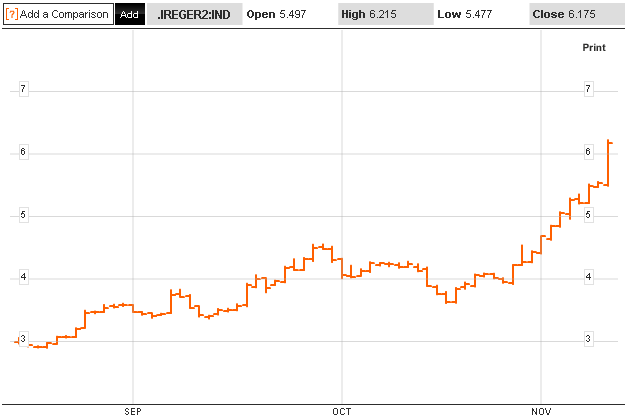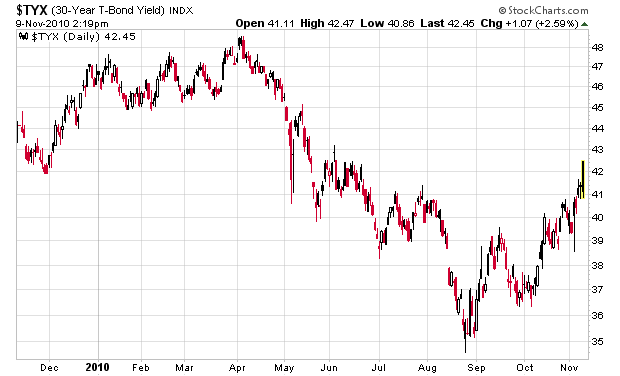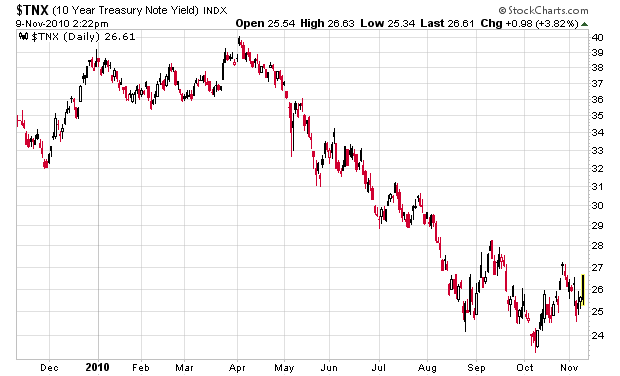As readers here may remember, my TFSA investment (which I am trying to compound as quickly as possible) was in First Uranium debentures (TSX: FIU.DB), unsecured senior debt, coupon 4.25%, maturing June 2012.
This has been one of my lesser performing investments, due to a horrible entry point (the company announced some adverse news shortly after my investment), which I had an opportunity to see the writing on the wall and liquidate (which I could have received a very acceptable price), but unfortunately my worst decision in the year was to not.
Anyhow, my TFSA is currently sitting about $600 below the end of December 2009 mark (netting out the $5,000 deposit), which is not too good since my other (fixed income) investment candidates at the time would have resulted in an actual increase on investment, which is the whole point of the TFSA. If I was planning on losing money, I would have prefered to do it in the RRSP or in the non-registered account so I could deduct the loss. C’est la vie – that’s how things work sometimes. The question is now, how to get back on track?
The first thing to look at is whether the underlying securities are still worth keeping based on new information that has been received in the interim. First Uranium went through a recapitalization which saw common shareholders be diluted in the form of a convertible notes offering (senior, secured by all assets minus what Gold Wheaton is entitled to, maturing March 31, 2013, convertible at $1.30/share, 7% coupon, TSX:FIU.NT) and a 14 million share settlement to Gold Wheaton (TSX: GLW) since FIU did not finish constructing a mine module in time. The company itself remains active in the gold mining industry (despite the company’s name, Uranium is a small part of the business), having two mines operating – Mine Waste Solutions (which is operating well and is profitable) and Ezulwini (which has been a basket case operationally and has been losing money). After firing most of the board and management, it appears there are hints that the company is coming back to financial life again, especially with gold prices at the high prices they are at today.
The company’s financials, once they stop spending big cash on capital expenditures, should be cash generating and healthily profitable even if you believe they will moderately underperform the economic projections in the technical reports. So it becomes a matter of whether the market believes the management can deliver operationally, and whether the management is credible. Given the history of the company, they are not and the common stock and debentures trade as if this is the case.
Thus, this is a high risk, high reward scenario. I have only gone superficially into one of the risks in this post, but there are other risks that I have mentally dissected.
While I do not think this investment is a slam dunk, when you adjust it for risk/return, there is a compelling investment thesis on the debt of First Uranium, and possibly the equity, which appears to be somewhat undervalued. There is a huge amount of default risk for the equity holders, and some risk for the unsecured debenture holders, and limited risk for the secured note holders.
The TFSA transaction that I recently performed was to sell half the debentures ($12k face) at 70 cents on the dollar, and then use the proceeds to purchase $10k face of notes, which I subsequently purchased at 88.5 cents on the dollar.
Why would I trade lower priced unsecured notes, maturing earlier (and a better annual compounded yield at existing trading prices) for more expensive, secure notes with a later maturity and less yield? The quick answer is that I am trading yield for quality.
The longer answer is that I am reasonably confident that the secured note holders would be able to receive the full principal amount in a bankruptcy liquidation of First Uranium. There is $150M outstanding and the company is likely to fetch more than this from Mine Waste Solutions alone. The upside for the noteholders (beyond a payout at maturity) is the $1.30 strike price, 2.5 year call option embedded in the notes, which provides a mild amount of equity participation without actually having to own the equity. The equity is currently about 67% out of the money as of this writing.
If FIU does get its act together, it is likely that the equity will increase higher than 67%. However, the equity is far too risky in the TFSA – it is better suited to a non-registered account where you can at least book capital losses if it tanks.
Finally, there is the scenario of what happens to the unsecured debenture holders when their maturity hits (June 2012) – the company will either likely make an offer to extend the maturity or give the debenture holders a sweeter deal (higher coupon and lower conversion rate) while the company tries to make its mining operations profitable. I do not think the unsecured debenture holders will force the company into bankruptcy simply because of their rank – they have relatively less negotiating power.
I will emphasize that equity in First Uranium is a highly risky investment, and the debentures are a risky investment, but the notes appear to be less risky, and are priced to represent the lower risk.
The notes are also better positioned in the TFSA (since you will likely see your money back), while debentures are better positioned in the RRSP (income is tax-deferred, but you can still benefit if you have a loss of prinicpal), and equity is positioned in the non-registered account.




